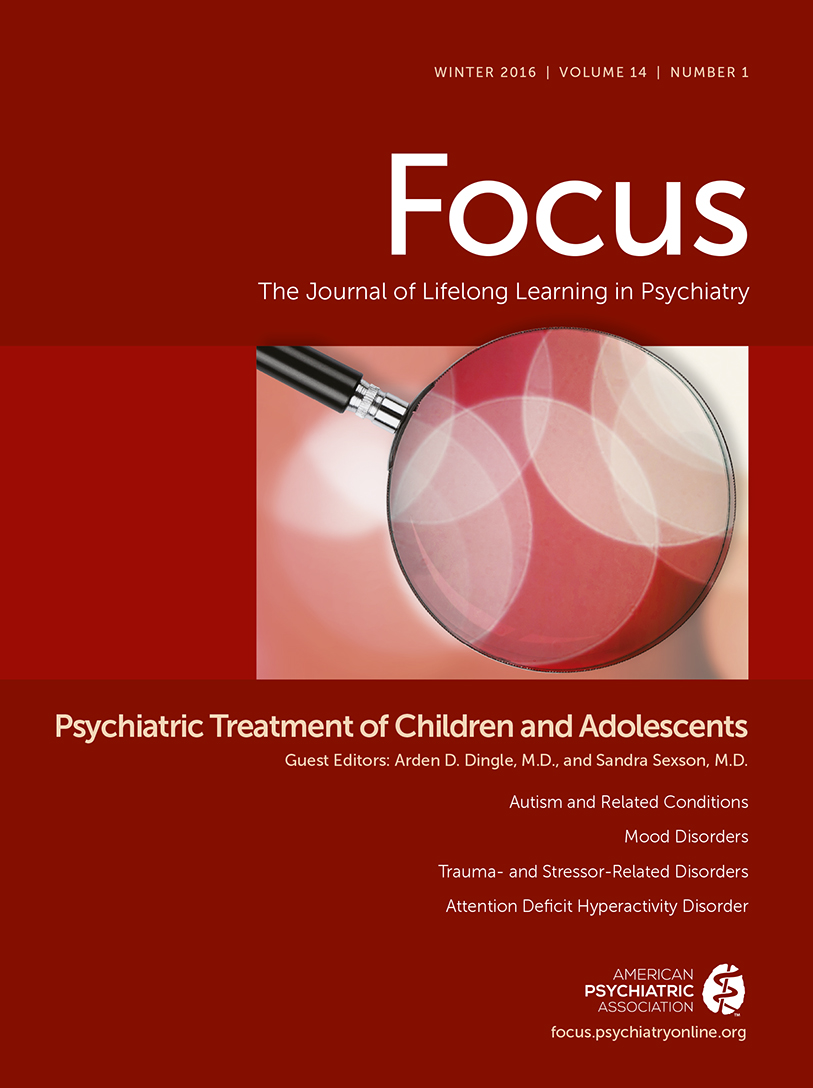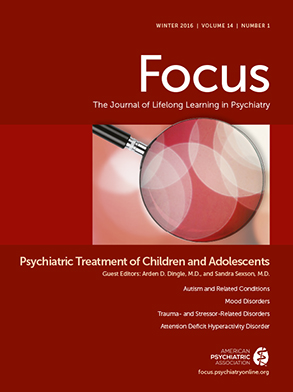DSM-5 (
1) defines a mood episode as a “distinct period” different from the person’s “usual self,” during which specific symptoms co-occur. For mania, these symptoms include an “abnormally and persistently elevated, expansive, or irritable mood” and “persistently increased goal-directed activity or energy.” Symptoms are accompanied by at least three additional symptoms (four if mood is irritable), such as inflated self-esteem or grandiosity, decreased need for sleep, pressured speech, flight of ideas, distractibility, increased activity in work or socially, or psychomotor agitation and excessive involvement in activities with a high potential for painful consequences. To meet full criteria for mania, symptoms must last at least 1 week (or 4 days for hypomania). The mood disturbance must be “sufficiently severe to cause marked social or occupational functioning” or hospitalization.
Episodes of depression, which must last a minimum of 2 weeks, are characterized by a sad, empty, or irritable mood, along with other symptoms of feeling worthless, preoccupation with death or suicide, agitation or feeling slowed down, and changes in appetite, sleep, and energy level. The diagnosis of dysthymic disorder, now called persistent depressive disorder, has a 1-year requirement for children, rather than the 2-year requirement for adults.
Neurobiology
There is a consensus that bipolar disorder is a neurobiological disorder, or possibly a group of disorders. Genetic influences explain approximately 60%–93% of the variance, whereas shared and unique environmental factors account for 30%–40% and 10%–21%, respectively (
8). Findings from studies in which offspring of bipolar parents were compared with offspring of nonbipolar parents invariably have shown significantly higher rates of psychopathology in general and bipolar I in particular among the offspring of bipolar parents (4%–6% in most studies). One recent study of bipolar parents’ offspring followed to age 18 years showed rates of 74.2% for any diagnosis (versus 48.4% for controls), 3.8% for bipolar I disorder (versus 0.4% for controls), and 10.5% for bipolar disorder not otherwise specified (versus 1.2% for controls) (
9).
Similar to studies of adults, results from both structural and functional MRI studies indicate that early-onset bipolar disorder is associated with abnormalities in the cortical and subcortical brain regions involved in the regulation of emotion and executive function. Nevertheless, there are some differences for children compared with adults. Amygdala, prefrontal, and visual system hyperactivation relates to the emotional dysfunction present among youths with bipolar disorder. Anterior cingulate cortex hypoactivation is relevant to the cognitive deficits of youths with bipolar disorder (
10).
There is some agreement among studies of neuropsychological functioning of youth with bipolar disorder compared with healthy control subjects, showing that verbal and visual-spatial memory, processing speed, working memory, and social cognition are impaired among youths with bipolar disorder. The degree to which this is confounded by attention-deficit hyperactivity disorder (ADHD) or other comorbidities with mood dysregulation is not clear (
11).
Assessment
Screening measures, completed by multiple informants (e.g., parent, teacher, or child), are useful in alerting the clinician to possible current symptoms of mania, depression, and other possible comorbidities (
12). Collateral information, such as teacher input, is helpful in determining whether manic-like symptoms are occurring across settings (
13). However, interviews with the caregiver(s) and child and a review of other diagnostic information are required. To be most efficient, caregivers should be interviewed first for a history of current symptoms, developmental history, and longitudinal course to date. The teen or child can verify mood symptoms, anxiety, psychosis, and abuse information and can be observed for rapid speech, thought disorder, and affect. Several rating scales have been developed to measure the severity of mania, including an interview measure; the Young Mania Rating Scale (Y-MRS), which is used in both adult and youth medication trials (
14); and parent rating forms for the child, including the Child Mania Rating Scale (
15) and the General Behavior Inventory (
16).
Comorbidities
Symptoms of mania may overlap with those of concurrent ADHD and oppositional defiant/conduct disorder, depression, and anxiety, precisely the conditions in which co-occurrence is highest (
17,
18). ADHD is the most common comorbid diagnosis among children with bipolar disorder, with published rates of 70%−95% among preadolescent youths and 50% among adolescents. In making the diagnosis of mania, the reason that episodes of elation and grandiosity receive emphasis is that ADHD, by contrast, is a chronic (rather than an episodic) disorder (
19). Another difficult diagnostic distinction is between agitated, anxious depression and a mixed episode of mania. Rates of conduct disorder and oppositional defiant disorder are reported to be as high as 79% for youths with bipolar disorder; anxiety comorbidity (up to 77%) and features of autism spectrum disorders (20%) are also substantial, although rates of comorbidity depend on whether a particular symptom is counted toward more than one disorder (
20). Substance abuse is a common co-occurrence among teens and may be associated with prior conduct disorder (
17). Young bipolar people with substance use problems had conduct disorder rates that were three times those of individuals without substance abuse problems (52% versus 14.8%; p<0.01) (
21).
Course and Outcome
The duration of a manic episode is longer in childhood-onset bipolar disorder (78 weeks in the Course and Outcome of Bipolar Illness in Youth [COBY] study) than in adolescent-onset disorder. Among those children and adolescents who achieve remission, rates of relapse range from 27% among community-based adolescents at 2-year follow-up to 70% among child and adolescent outpatients at 4-year follow-up. In addition to earlier age of onset, general risk factors for longer episode duration include poor treatment adherence, rapid cycling, psychotic symptoms, lower socioeconomic status, and comorbid anxiety, ADHD, and/or disruptive behavior disorders (
22,
23).
Latent-class growth analysis data from the COBY 8-year follow-up study (
23) of 367 outpatients (mean age 12.6 years) who were interviewed every 6 months revealed four types of outcomes: predominantly euthymic (24% of sample; 84% of the time), moderately euthymic (34.6% of sample; approximately 47% of the time), ill with improving course (19.1% of sample; 43% of the time), and predominantly ill (22.3% of the sample; 12% of the time). As with longer episode durations, more time ill was associated with younger age of onset as well as more severe depression, more subsyndromal symptoms, more suicide attempts and sexual abuse, more comorbidity, and more family psychopathology.
Other studies suggest a worse outcome for early-onset bipolar disorder; however, as with many divergent findings in this field, much depends on how bipolar disorder is defined (
20).
Functional outcome outside of symptom status has not yet been addressed in long-term longitudinal studies.
Pharmacotherapy
As of 2015, the U.S. Food and Drug Administration (FDA) has approved the following treatments for mania among adolescents: lithium, chlorpromazine, olanzapine, quetiapine, risperidone, aripiprazole, and asenapine. Risperidone, aripiprazole, quetiapine, and asenapine are approved for children as young as age 10. Lithium and chlorpromazine were approved before specific data for youths were required. Five of the atypical antipsychotic medication trials were in response to an FDA written request for age guidelines in the treatment of acute and mixed mania. For these drugs, using a response rate of a 50% reduction in Y-MRS entry scores or a decrease of Y-MRS scores of between 14 and 18 points, in general, 45%–65% of patients improved when taking active medication compared with 18%–37% of those taking placebo (a reduction of 8–10 points on placebo). This translates to an effect size of 0.65 (confidence interval=0.53–0.78) compared with placebo (effect size=0.20; confidence interval=0.02–0.39) (
24). Most studies had low-dose, high-dose, and placebo arms, with both doses separating from placebo but greater side effects for the high-dose condition without a correspondingly higher improvement.
Among anticonvulsant mood stabilizers, although divalproex and long-acting carbamazepine are approved by the FDA for mania treatment of adults, data for youths with bipolar disorder are less robust. Divalproex has appeared to be effective in small, controlled and open-label trials, but these trials did not include a placebo arm. Results of a large, industry-sponsored trial requested by the FDA with extended-release divalproex were negative; drug and placebo responses were 24% and 23%, respectively (
25). A published trial of oxcarbazepine was not significantly better than placebo (
26); furthermore, topiramate has not been adequately studied with youths because the trials with adults were stopped for lack of efficacy (
27). Second-generation antipsychotics outperform divalproex and, where measured, time to response is shorter (
28). A randomized, nonplacebo-controlled study comparing lithium, divalproex, and risperidone reported response rates of 35.6% for lithium, 24% for valproate, and 68% for risperidone (
29).
Lithium efficacy for children was previously derived from small trials, open-label trials, and discontinuation trials, but none addressed acute mania with a placebo control until recently. In the recent Collaborative Lithium Trial, researchers found a 4.5-point difference on the Y-MRS scale at week 8 between lithium- and placebo-treated participants (p=0.031). Even so, response rates (≥50% decrease in Y-MRS) did not differ significantly between the lithium and placebo groups, respectively (37.7% versus 28.6%) (
30).
Just as comorbidity is the rule diagnostically, the need to use more than one medication to treat severe mood disorder in children is a frequent occurrence. Data are available for three types of studies: comparing two medications to one, such as combined divalproex and quetiapine versus quetiapine alone (
31); adding one to another if the first drug does not work, such as adding risperidone to lithium or divalproex (
32); and starting two drugs together, such as lithium and divalproex, and then discontinuing one drug (
33). In general, combined strategies have been more powerful but also carry more side effects.
ADHD is a moderator of treatment response (
34,
35). There are three types of studies that address the combination of mania and ADHD: adding a stimulant to ongoing divalproex treatment, adding methylphenidate to other thymoleptics, and adding atomoxetine to a mood-stabilized regimen (
36–
39). In most cases, ADHD treatment has been managed without destabilizing the bipolar disorder.
Anxiety disorders are another complicating comorbidity for bipolar disorder, which worsen both outcome and treatment response. Unfortunately, there are currently no treatment studies to provide guidance for treatment of adults or youths. Although data suggest that adults do better with mood stabilizers added to antidepressant and antianxiety treatment, clinicians are advised to be very sure that the condition being treated is truly bipolar disorder. Otherwise, the anxiety disorders, which have a greater likelihood of occurrence for youths, will go untreated out of fear of making the person worse. Data are mixed regarding how much protection is provided by using a mood stabilizer or antipsychotic first and then adding a selective serotonin reuptake inhibitor or serotonin-norepinephrine reuptake inhibitor (
40). A trial of anxiety disorder–based cognitive-behavioral treatment is also a possibility.

